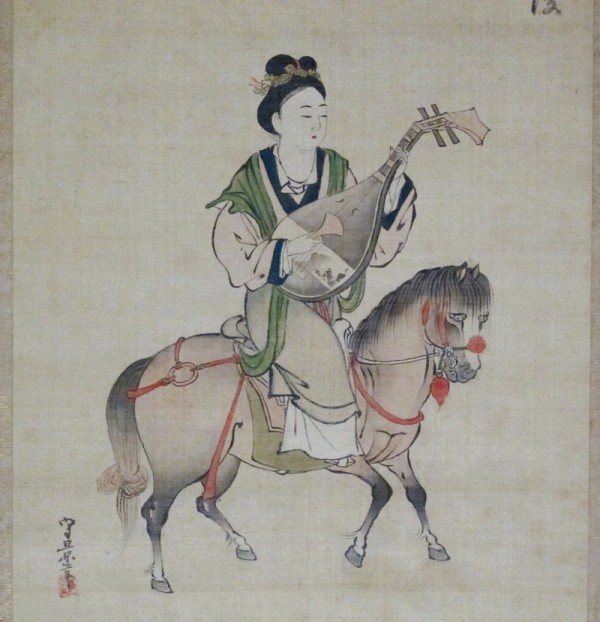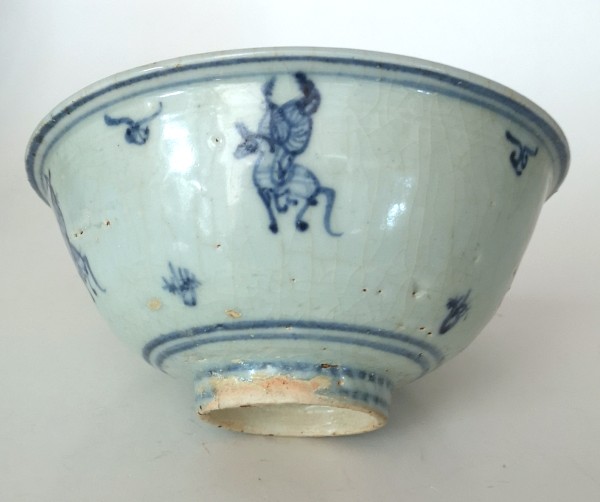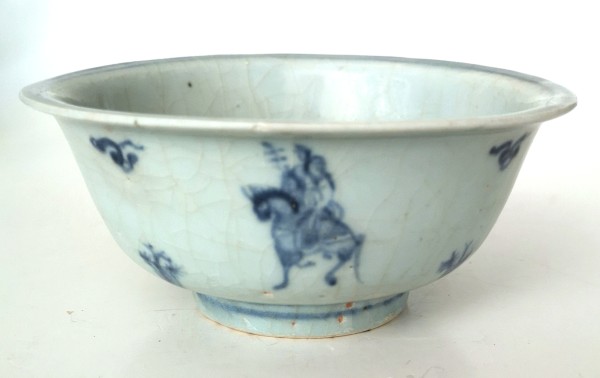
As popular lore has it: Wang Zhaojun left her hometown on horseback on a bright autumn morning and began her journey northward. As she sat on the saddle, she began to play sorrowful melodies on a pipa (a round-bodied lute - ruanxian). A flock of geese flying southward heard the music, and saw the beautiful young woman riding a horse, were so touched they forgot to flap their wings, and fell to the ground.

A blue and white Ming dynasty bowl featuring the design of Han beauty Wang Zhaojun en route to marrying the Xiongnu chieftain Huhanye Chanyu. Four riders possibly intercepted by four geese. According to "A Comprehensive View of Ming Dynasty Folk Blue and White Porcelain, Compiled and edited by Hu Yanxi", fig 144, 145, dated to Hongzhi 1488-1505. Photo: JE Nilsson Coll. 2024

Bowl with what in Sweden was called Marco Polo decoration before this decoration was properly identified. Wang Zhaojun is perhaps the best known of China's "political brides". Ming dynasty, Hongzhi 1488-1505 or Zhengde 1506-1521. Photo: JE Nilsson Coll. 2024
Wang Zhaojun is a well-known figure in Chinese history and folklore. She lived during the Western Han dynasty (206 BC – 8 AD). She was selected to be one of the emperor's concubines but lived in relative obscurity because she was not favored by the emperor. In 33 BC she volunteered in a political arrangement to marry Huhanye Chanyu, the leader of a northern Xiongnu tribe.
Wang Zhaojun was a real person, She was born to a prominent family in Baoping Village, in Zigui County (in current Hubei Province) Her name was Wang Qiang, and Zhaojun her style name. As her father was very old when she was born, he cherished her deeply, calling her "a pearl in the palm." Wang Zhaojun was renowned for her stunning beauty and exceptional intelligence. She excelled in playing the pipa and mastered the ancient "Four Arts of the Chinese Scholar" – the guqin, go, calligraphy, and Chinese painting.
In 36 BC, Emperor Yuan of Han selected his concubines from across the state. Due to her local fame, Wang Zhaojun was his first choice as a concubine from the southern part of the Western Han. Despite her father's protests that she was too young, he could not defy the imperial decree. Wang entered the emperor's harem in early summer.
All women living in the Forbidden City were carefully tucked away in the imperial quarters deep inside the palace. They were restricted to the inner court and forbidden from venturing out of the northern section.
Most women in the Forbidden City were employed as maids and servants, but there was also a select group of concubines whose task was to bear children for the emperor – as many as he could father. Those who gave birth to male offspring were elevated to imperial consorts, with the empress at the top of the pecking order.
According to palace customs, the emperor chose his new wives by reviewing their portraits. Confident in her beauty she refused to bribe the artist Mao Yanshou as the other maids did. As a reprisal Mao Yanshou painted an unflattering portrait of Wang (adding a crying widow's mole) and, as a result, Wang Zhaojun was never visited by the Emperor Yuan.
In 33 BCE, Huhanye Chanyu, the leader of the Xiongnu, proposed marriage to the Han court as a gesture of goodwill to strengthen the peace between the Han and the Xiongnu.
Typically, the daughter of a concubine would be offered, but Emperor Yuan, unwilling to honor Huhanye with a real princess, ordered the plainest girl in the harem to be chosen. He asked for volunteers and promised to present the chosen one as his own daughter. Most young women found the idea of leaving their homeland and court life for the distant northern grasslands unappealing, but Wang Zhaojun volunteered to marry the chieftain.
The matron of the harem sent the unflattering portrait of Wang to the Emperor, who glanced at it and nodded approval. When Wang Zhaojun finally was presented to the court, her true beauty was revealed. The Emperor wanted to retract his decision, but it was too late, why he regretfully presented Wang Zhaojun to Huhanye.
Huhanye was delighted and the relations with the Xiongnu improved. The artist Mao Yanshou was executed for his greed, and for deceiving the Emperor.
Wang Zhaojun is remembered for her bravery and selflessness. She is celebrated as a symbol of peace and friendship between different cultures. It is an historic fact that her marriage helped to establish a lasting peace and fostered cultural exchange between the two regions.
The Xiongnu were a confederation of nomadic tribes from the Central Asian steppes, known to have existed from around the 3rd century BCE to the 1st century CE. They are often associated with the Huns in Western sources and were significant players in the geopolitics of ancient China.
The Xiongnu were predominantly nomadic, relying on herding, hunting, and raiding for sustenance. They were known for their formidable cavalry and frequently clashed with the Chinese states along the northern frontier. The relationship between the Xiongnu and the Chinese dynasties varied, ranging from open conflict to diplomatic marriages and trade agreements, such as the marriage of Wang Zhaojun to the Xiongnu chieftain.A